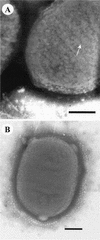Characterization of the novel factor paa involved in the early steps of the adhesion mechanism of attaching and effacing Escherichia coli
- PMID: 12874331
- PMCID: PMC166039
- DOI: 10.1128/IAI.71.8.4516-4525.2003
Characterization of the novel factor paa involved in the early steps of the adhesion mechanism of attaching and effacing Escherichia coli
Abstract
Nonenterotoxigenic porcine Escherichia coli strains belonging to the serogroup O45 have been associated with postweaning diarrhea in swine and adhere to intestinal epithelial cells in a characteristic attaching and effacing (A/E) pattern. O45 porcine enteropathogenic E. coli (PEPEC) strain 86-1390 induces typical A/E lesions in a pig ileal explant model. Using TnphoA transposon insertion mutagenesis on strain 86-1390, we found a mutant that did not induce A/E lesions. The insertion was identified in a gene designated paa (porcine A/E-associated gene). Sequence analysis of paa revealed an open reading frame of 753 bp encoding a 27.6-kDa protein which displayed 100, 51.8, and 49% homology with Paa of enterohemorrhagic E. coli O157:H7 strains (EDL933 and Sakai), PEB3 of Campylobacter jejuni, and AcfC of Vibrio cholerae, respectively. Chromosomal localization studies indicated that the region containing paa was inserted between the yciD and yciE genes at about 28.3 min of the E. coli K-12 chromosome. The presence of paa and eae sequences in the porcine O45 strains is highly correlated with the A/E phenotype. However, the observation that three eae-positive but paa-negative PEPEC O45 strains were A/E negative provides further evidence for the importance of the paa gene in the A/E activity of O45 strains. As well, the complementation of the paa mutant restored the A/E activity of the 86-1390 strain, showing the involvement of Paa in PEPEC pathogenicity. These observations suggest that Paa contributes to the early stages of A/E E. coli virulence.
Figures







References
-
- Akita, E. M., and S. Nakai. 1993. Comparison of four purification methods for the production of immunoglobulins from eggs laid by hens immunized with an enterotoxigenic E. coli strain. J. Immunol. Methods 160:207-214. - PubMed
-
- An, H., J. M. Fairbrother, C. Desautels, and J. Harel. 1999. Distribution of a novel locus called Paa (porcine attaching and effacing associated) among enteric Escherichia coli. Adv. Exp. Med. Biol. 473:179-184. - PubMed
-
- An, H., J. M. Fairbrother, C. Desautels, T. Mabrouk, D. Dugourd, H. Dezfulian, and J. Harel. 2000. Presence of the LEE (locus of enterocyte effacement) in pig attaching and effacing Escherichia coli and characterization of eae, espA, espB and espD genes of PEPEC (pig EPEC) strain 1390. Microb. Pathog. 28:291-300. - PubMed
-
- Barondess, J. J., and J. Beckwith. 1990. A bacterial virulence determinant encoded by lysogenic coliphage lambda. Nature 346:871-874. - PubMed
Publication types
MeSH terms
Substances
Associated data
- Actions
LinkOut - more resources
Full Text Sources
Other Literature Sources
Research Materials

